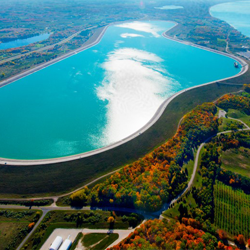An Inside Look Into How The Ludington Pumped Storage Plant Powers Michigan
Old School Waterpower Primes Clean Energy Future
Our blueprint to serve customers reliable energy with net zero carbon emissions by 2040, the Clean Energy Plan, is made possible by a 50-year-old hydroelectric plant nestled on the shores of Lake Michigan.The Ludington Pumped Storage Plant, co-owned by Consumers Energy (51%) and DTE Electric (49%), is a key component to helping both energy providers replace coal generated power with clean, renewable energy that will keep Michigan powered.
When was the Ludington Pumped Storage Plant built?
 The massive undertaking of constructing the generating plant began in 1969.
The massive undertaking of constructing the generating plant began in 1969. Longtime Ludington locals still refer to the facility as “The Project.” It was the largest pumped storage facility in the world when it was built and took two years to bulldoze the 2.5 miles long, one mile wide, 840-acre reservoir that measures over 100 feet deep and can hold 27 billion gallons of water. When opening for operation in 1972, it was the largest pumped storage facility in the world and remains to be one of the largest hydroelectric power plants in terms of capacity in the United States.
Considered a modern marvel, The American Society of Civil Engineers awarded the project the Outstanding Civil Engineering Achievement in 1973, and it was named one of the top 10 civil engineering projects of the 20th century in Michigan. At the time, the facility cost about $327 million to build, which is roughly $2.7 billion today when calculating for inflation.
Why was the Ludington Pumped Storage Plant built?
Ludington Pumped Storage was built at a time when nuclear power plants were coming online across the country with even more being planned. It was originally built to act as a big battery to store energy from nuclear power plants and level the load for the bulk electric system supporting nearby plants, such as from nearby D.C. Cook Nuclear Power Plant and Palisades Nuclear Power Plant. Nuclear plants and coal generating plants are not efficient to stop and start up again so they are designed to run as baseload around the clock. The pumped storage facility replaces the need to build plants used only during peak demands and instead uses excess power on the grid at night and weekends when customer demand is low to move water uphill into the reservoir where it is stored. It takes just minutes to release water downhill for the plant to start generating electricity.How does the Ludington Pumped Storage Plant work?
Ludington Pumped Storage is a hydroelectric power plant that uses stored water at elevation to function like a battery. When electricity prices are low, the large reservoir above Lake Michigan is filled with water from through six large pipes 28 feet in diameter, called penstocks, each equipped with a reversable pump turbine. It takes about nine hours to move enough water from Lake Michigan to fill the reservoir.When demand for electricity rises, the plant is dispatched and water produces power like a river hydro dam turning turbines as it is released 363 feet back into Lake Michigan.
With a 2,292-megawatt capacity, the Ludington Pumped Storage Plant can power a city with a population of approximately 1.4 million people for about eight hours.
The Ludington Pumped Storage Plant can be activated quickly to begin producing power when demand rises.
What is hydroelectricity?
Hydroelectric energy comes from the power of moving water. In the case of the Ludington Plant, the water falls from the reservoir back into Lake Michigan, turning large turbines. The shaft of the turbine connects back to the generator to produce the electricity. That electricity can then be transported to homes and businesses across the state.What are the benefits of the Ludington Pumped Storage Plant?
 Hydroelectric pumped storage facilities allow energy providers to build greater amounts of stored energy to meet energy demand. Demand for electricity is not constant, it ebbs and flows. Pumped storage also works in tandem with wind and solar, forms of energy generation that work intermittently, to ensure the grid always has a strong supply of electricity.
Hydroelectric pumped storage facilities allow energy providers to build greater amounts of stored energy to meet energy demand. Demand for electricity is not constant, it ebbs and flows. Pumped storage also works in tandem with wind and solar, forms of energy generation that work intermittently, to ensure the grid always has a strong supply of electricity. Since its infancy, the Ludington Pumped Storage Plant’s reservoir has typically been filled on weekends and nights. That’s because those times are when demand for electricity is low and excess energy is available from constantly running plants. That model is evolving as solar energy becomes dominant as a fuel source.
How does the Ludington Pumped Storage Plant store energy?
The Ludington Pumped Storage Plant’s schedule may adjust to running when the sun is fueling solar panels. The Plant will need to then use its reversable pump turbines to fill the reservoir as stored energy during the day periods when the solar projects are producing more electricity than needed for Michigan’s homes and businesses. The function of the big battery will then be reversed and water released from the reservoir will be used to generate electricity when grid and customer demand for power rises.Consumers Energy is planning to add 8,000 megawatts of solar energy to serve customers cleanly by 2040 as it decommissions coal generating plants.
Comparing batteries to batteries
As Michigan energy providers shift to serving customers with clean, renewable energy and away nuclear and coal, researchers are actively and successfully improving battery technology.However, the capacity of even the newest batteries, such as lithium-ion versions, are dwarfed by the nearly 16,000 megawatt hours that can be provided by Ludington Pumped Storage. For instance, Consumers Energy is ushering in a new era of battery storage at Western Michigan University in Kalamazoo, Michigan. Its new high-tech battery there has a 1-megawatt hour capacity that can power 1,000 homes at any given time.
Upgrades increase efficiency
A large-scale project is taking place to increase the generating capacity of the plant by replacing the original six turbines, increasing the generating capacity of each unit by 50 megawatts for a total increase of 300 megawatts. In addition, the new units reduce the time to fill the reservoir and reduce the frequency of scheduled outages. The project was expected be completed in 2019 but experienced delays.Ludington Pumped Storage to the rescue
The Ludington Pumped Storage Plant provides value to customers every day, but in 2003 it came to the rescue during the massive blackout.When much of the grid experienced a cascading blackout affecting 55 million people in Ohio, Michigan, Canada, Pennsylvania and other states August 14, 2003, employees were able to quickly respond and start up the Ludington Pumped Storage Plant. The power from the Ludington facility helped to limit the blackout growth. Only 100,000 Consumers Energy customers lost power in the blackout.
The Plant, relicensed in 2019 to operate until June 30, 2069, played a key role that fateful day in 2003 and will continue to play a key role in Michigan’s clean energy future.